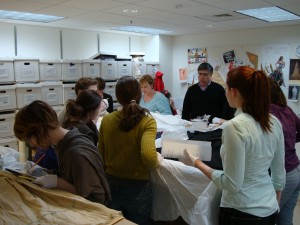March 11, 2010
Working on this project has provided me with an interesting opportunity to consider the practical impact of using a digital collection in conjunction with a physical collection. The physical project is in an “awkward stage” right now – this is our opportunity to get objects out of boxes, see if they really are what we think they are, write better catalog entries and condition reports, and re-sort them into different boxes accordingly.
We can’t just sort by period, or by function, or by condition, or by fiber – all of those come into play. Up to now we’ve mostly been sorting by period – but then when a student is just interested in underwear, all of that comes out together. Then when we find several things with mildew, they have to go in yet another area, in quarantine from the other objects. Meanwhile, every available flat surface is stacked with piles of objects wrapped in acid-free tissue.
In my digital collection, everything’s so much more neat and tidy. With practically one click, I can sort everything by fiber type. I can sort everything chronologically. I can sort everything by function. If only it were that simple with the piles all over the costume shop!
Here’s where it’s so important how the digital and physical work together: once we have everything better documented in the database, then the database can help us to play around with different physical storage configurations and figure out what is most feasible. Indeed, that’s a major point of the current project. We can’t properly take care of what we have until we really know what we have. If we’re sorting by period, it’s very important that everything is properly dated. Perhaps more importantly, if we really want to preserve our textiles, we need to have some ability to store them by fiber type.
So what do we do with all the physical objects until then? I’m eager to buy some new storage boxes right away (and we have a tiny bit of grant money to do so), but our storage plan is still evolving as more documentation occurs. I’m afraid to invest in anything in case our plan changes dramatically. With all we’ve learned so far this semester about best practice for textile preservation, it’s heartbreaking at times for us not to be able to put some things properly “away.”
But I keep reminding myself – that is what this project is about. We’re figuring it out. By the end of the semester, we’ll have a better condition assessment in place, and we’ll be able to define our strategic plan, mainly regarding storage.
